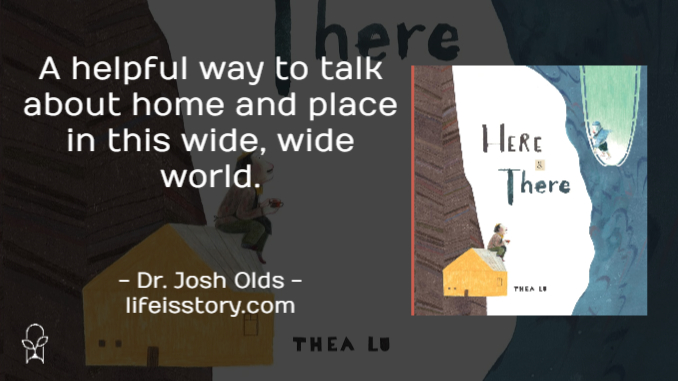
Published by Eerdmans Books for Young Readers on April 23, 2024
Genres: Children's
Buy on Amazon
Goodreads

A thoughtful book that will resonate with travelers, homebodies, and anyone who’s ever longed for an old friend or a new journey.
Dan is the owner of a café, living in a small town on the coast. Aki is a sailor on the sea, traveling from place to place. Dan loves his familiar views and enjoys welcoming visitors from far away. Aki loves the wonders he sees abroad and enjoys meeting new people in distant lands. Though Dan likes his life, and Aki likes his life, they each feel so alone sometimes. But every once in a while, separate lives can collide and make the world feel large and small all at once.
Following the parallel stories of Dan and Aki, Here and There introduces readers to two contrasting yet connected characters. Thea Lu’s evocative text and art will spark lasting conversations about home, travel, and the similarities between very different people.
My six-year-old is a world traveler. In the short time he’s been alive, we’ve lived in six houses in six different cities across three states and two countries and had holidays in even more. As I write this, we are three weeks away from moving back across the Atlantic for a summer of travel throughout the United States while setting up our next adventure. And despite all this, the wanderlust still gets to him and he’ll spend hours on Apple Maps walking virtually through cities he wants to visit, plotting pathways and finding the best forms of travel (which is always by train). Yet, he’s also very much home at home. He likes his room, he likes solitude, he likes quiet. Reading Here & There by Thea Lu very much reminded me of his spirit.
Here & There is a story of contrasts. Dan is the owner of a café who lives in a small town by the sea. He stays. People come to him. Aki is a sailor who lives in no one place but instead travels from place to place. He goes to people. Lu contrasts their lives, showing them to be very different yet somehow comfortingly the same. She glorifies neither Dan’s rootedness or Aki’s sense of adventure. Rather, Here & There accepts these two different personalities and show how they get their social needs met in ways that are different yet rather the same. Sometimes they both feel alone. Sometimes they wonder if their life is the best. But in the end, they each find human connection and community in their own way.
Here & There invites introspection and reflection. Who are you? Are you more like Dan or Aki? What is the value of rootedness? What is the value in adventure? How do the two interconnect? The answer, never stated explicitly but borne out through the story is that both types of folk need the other. They function in a symbiotic relationship that bringing meaning and fulfillment to the other. The rootedness of the places Aki visits gives him places of hospitality. The adventurers that Dan invites into his café gives him a sense of newness.
As we get closer to moving, I’ve been reading this book with my kids and they get it. Mamaw and Papaw are the Dans. We’re moving back into their house—the same house that I grew up in, the same house that they’ve lived in for thirty years. Their rootedness enables our wandering. We are the Akis (at least at this stage of life), able to go and see new things. It’s been a helpful way to talk about the move, about traveling, and about the importance of home and place within the wide, wide world.
